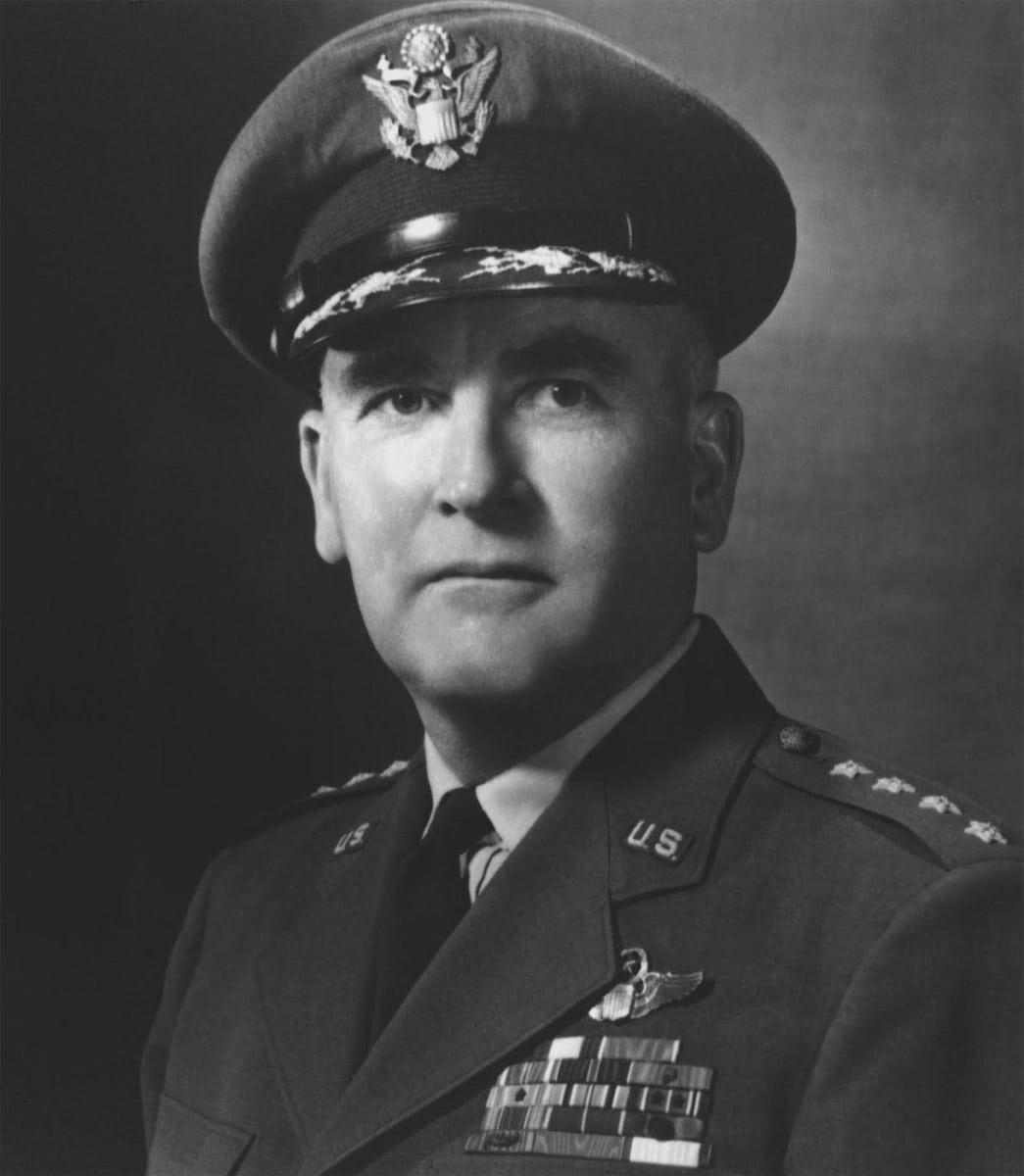Project Grudge was a short-lived United States Air Force investigation into reports of UFOs. Formed in 1949 as a replacement for the Air Force’s first official UFO investigation, Project Sign. Grudge was criticized for its lack of scientific rigor, with many researchers and former members accusing it of being a disinformation campaign designed specifically to reduce public interest in the flying saucer phenomena.
Project Grudge only produced one official report in 1949 and was terminated at the end of 1949, although it continued to operate in a diminished capacity until 1951. The Air Force ultimately replaced Grudge with the more well-known Project Blue Book in 1952, an effort that ran until 1969.
Formation and Meaning of Name
Following reports of flying disks and other unexplainable aerial phenomena in 1947, the U.S. Air Force began to look into the issue. After an initial investigation by the Army Air Force Air Material Command, General Nathan F. Twining issued the famous Twining memo that same year, a document which, among other things, concluded the following:
a. The phenomenon is something real and not visionary or fictitious.
b. There are objects probably approximating the shape of a disc, of such appreciable size as to appear to be as large as man-made aircraft.
c. There is a possibility that some of the incidents may be caused by natural phenomena, such as meteors.
d. The reported operating characteristics, such as extreme rates of climb, maneuverability (particularly in roll), and motion which must be considered evasive when sighted or contacted by friendly aircraft and radar, lend belief to the possibility that some of the objects are controlled either manually, automatically, or remotely.
Twining’s memo led to the creation of Project Sign in 1947, an effort that lasted until 1949, when it was officially terminated, and Grudge was created to take its place. Most historians believe that Grudge was a direct reaction to a document purportedly prepared by the Sign tea known as the “Estimate of the Situation,” which, among other conclusions, offered the extraterrestrial hypothesis as the most likely answer to the origin of flying disks.
Original Project Blue Book chief and UFO historian Edward J Ruppelt wrote in his book “The Report on Unidentified Flying Objects” regarding the end of Sign and the creation of Grudge:
“More and more work was being pushed off onto the other investigative organization that was [sic] helping ATIC. The kickback on the Top Secret Estimate of the Situation was beginning to dampen a lot of enthusiasm. It was definitely a bear market for UFOs."
Also, according to Ruppelt, this environment led to a memo ordering the official termination of Sign and the implementation of a new UFO investigation called “Project Grudge.” Ruppelt wrote that Grudge was intentionally directed to come to a non-E.T. conclusion and that its name was meant to convey this new direction.
"The order was supposedly written because the classified name, Project Sign, had been compromised,” he writes. ”This was always my official answer to any questions about the name change. I'd go further and say that the names of the projects, first Sign, then Grudge, had no significance. This wasn't true; they did have significance, a lot of it."
Grudge Operation and Public Relations Campaign
After its formation, Air Force officials said that Grudge would be following “standard intelligence procedures” when investigating cases.
“This normally means an unbiased evaluation of intelligence data,” explained Ruppelt. “But it doesn't take a great deal of study of the old UFO files to see that standard intelligence procedures were not being followed by Project Grudge. Everything was being evaluated on the premise that UFOs couldn't exist. No matter what you see or hear, don't believe it.”
In fact, Ruppelt said the anti-extraterrestrial attitude surrounding the formation of Grudge was so obvious that some of "ATIC's [Air Technical Intelligence Center's] top intelligence specialists who had been so eager to work on Project Sign were no longer working on Project Grudge. Some of them had drastically and hurriedly changed their minds about UFOs when they learned the Pentagon was no longer sympathetic to the UFO cause."
Ruppelt described Grudge as the “Dark Ages” of U.S. Air Force investigations into UFOs.
In his book “UFOs, the Military, and the Early Cold War" author Dr. Michael D. Swords said, "Inside the military, [Maj. Aaron J.] Boggs in the Pentagon and [Col. Harold] Watson at AMC [Air Material Command] were openly giving the impression that the whole flying saucer business was ridiculous. Project Grudge became an exercise of derision and sloppy filing.”
Grudge’s efforts to debunk all UFO reports as either misidentified mundane objects or the result of fabrications by witnesses were bolstered by a Public Relations campaign in the media.
The first and most prominent effort was a two-part article by Sidney Shallet published in consecutive issues of the then-popular Saturday Evening Post on April 30 and May 7, 1949. In that series, Shallet echoed the Grudge position that all reports were easily explained as misidentifications or fabrications and that the media was to blame for blowing the whole thing out of proportion. The story was bolstered by quotes from high-ranking military officials who echoed the same position that there was nothing extraordinary to the flying disk phenomenon.
Historians indicate that Grudge officials participated in the story with hopes that it would quell public interest in UFOs. However, according to Ruppelt, Shallet’s admission that a small portion of reports seemed to defy analysis or explanation had the opposite effect and instead "planted the seed of doubt" in the minds of the general public.
The Official Project Grudge Report
Before its official termination, Grudge issued a lone report. Over 600 pages, the report's main conclusions were:
A. There is no evidence that objects reported upon are the result of an advanced scientific foreign development; and, therefore they constitute no direct threat to the national security. In view of this, it is recommended that the investigation and study of reports of unidentified flying objects be reduced in scope. Headquarters AMC [Air Materials Command] will continue to investigate reports in which realistic technical applications are clearly indicated.
NOTE: It is apparent that further study along present lines would only confirm the findings presented herein. It is further recommended that pertinent collection directives be revised to reflect the contemplated change in policy.
B. All evidence and analyses indicate that reports of unidentified flying objects are the result of:
1. Misinterpretation of various conventional objects.
2. A mild form of mass hysteria and war nerves.
3. Individuals who fabricate such reports to perpetrate a hoax or to seek publicity.
4. Psychopathological persons.
Termination of Grudge and Formation of Blue Book
Although officially terminated in December 1949 after the release of its lone official report, Grudge still operated in a diminished capacity through 1951.
In his book, “The UFO Book: Encyclopedia of the Extraterrestrial,” author Jerome Clark explains how Bob Ginna of Life magazine visited Wright Patterson Air Force Base in April of 1951 to study what remained of Project Grudge. According to Jerome Clark, Bob Ginna related "the project's manifest shortcomings." At this point, the lone official still assigned to Grudge was Lt. Gerry Cummings, and according to Ruppelt, the lieutenant found very little support for his work.
The tipping point for Grudge came in September 1951, when pilots and radar operators reported extremely fast, highly-maneuverable, disc-shaped objects flying over Fort Monmouth, New Jersey. Lt. Cummings was dispatched to investigate, along with Lieutenant Colonel N.R. Rosegarten, with both men spending the majority of September 13th interviewing the witnesses and collecting related documentation.
The two officers reported their results directly to Major General Charles P. Cabell, then the head of Air Force intelligence at the Pentagon and the man who had ordered the creation of Project Sign back in 1947. According to Clark, the meeting was already in progress when the two men arrived and the room was filled with tension. Cabell was reportedly frustrated with the low-quality efforts and sloppy debunking by Grudge. The General's frustration was further fueled by the report from Cummings and Rosengarten, whose witnesses, according to Clark, reported the objects as being “intelligently controlled.”

According to Ruppelt, it is at this point Lt. Cummings "cut loose. He told how every UFO report [submitted to Grudge] was taken as a huge joke" and that the project was essentially dead. For Cabell, the Fort Monmouth case further solidified his opinion that Grudge was lazy and sloppy and ignored obvious facts solely to debunk UFO.
According to Author Michael Swords, Cabell said in another meeting, "I want an open mind; in fact, I order an open mind! Anyone who doesn't keep an open mind can get out now! ... Why do I have to stir up the action? Anyone can see that we do not have a satisfactory answer to the saucer question."
Swords says Cabell repeated this position at a future meeting of high-ranking colonels, where he called the Grudge report “tripe” and said, “I've been lied to, and lied to, and lied to. I want it to stop. I want the answer to the saucers, and I want a good answer."

In late 1951, Cabell put Ruppelt in charge of the stripped-down Grudge. This decision reportedly came due to Ruppelt’s open-minded attitude, and according to author David Michael Jacobs, his “reputation as a good organizer.”
Still concerned that flying discs may have mundane explanations and hoping to keep the Air Force’s reputation intact, Cabell ordered Ruppelt to keep Grudge operating with a low profile, both within the Air Force and from the general public. Still, public interest in the subject increased dramatically in 1952, forcing the Air Force to go public, this time changing the effort’s name from Grudge to Project Blue Book.

J. Allen Hynek, an astronomy professor who consulted with the Air Force across all official UFO investigations from Sign to Grudge to Blue Book, was particularly critical of Grudge. Later in his life, and after his role with these programs was finished, Hynek said that the Project Grudge effort was "as far from an objective, scientific examination of the phenomenon as one could get" and that in his analysis, Grudge was "less science and more of a public relations campaign".